by Gregory & Elisabeth Benford
We left February 17, 2007 on a considerable, month-long trip, starting with Hong Kong, where we caught the Lunar New Year Celebration (Chinese New Year). Then on to Colombo, Sri Lanka, to visit Arthur Clarke. Arthur has post polio syndrome and thus very little memory or energy. He turns 90 this December and wants to keep in touch with the outer world, mostly through the Internet. He has few friends left in Colombo.
Arthur took us to the Swimming Club for lunch, a sunny ocean club left over from the British days (commonly called the Raj). Members swam in the pool and enjoyed buffet lunch. It felt somehow right to watch the Indian Ocean curl in, breaking on the rocks, and speak of space: the last, greatest ocean.
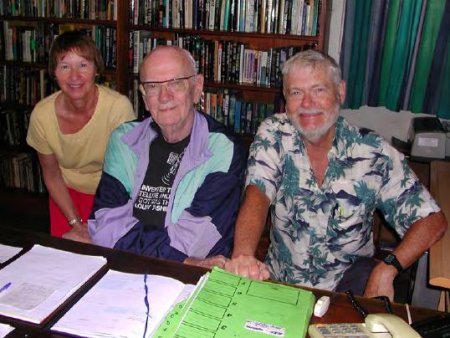
Image: Elisabeth, Arthur C. Clarke, and Greg in ACC’s home study in Colombo.
Our hotel with a similar ocean view, the Galle Face, is the oldest grand Raj hotel east of the Suez Canal, dating from before the Civil War, and reeks of atmosphere. On the verandah we daily dug into a good Lankan breakfast: string hoppers of woven rice, rich curry of meat and potatoes, idli (small steamed rice cakes), dosas (rice crepes) with various fillings, pappadums – cause for lascivious hunger. The full English breakfast was also available.
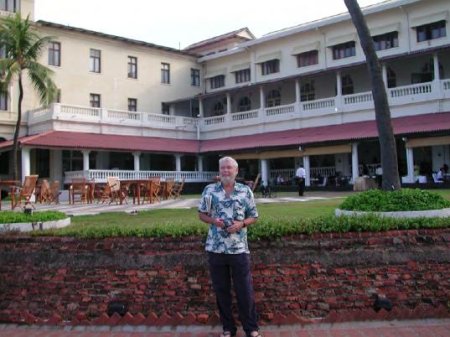
Image: Greg in front of the back lawn of the Galle Face Hotel. Note the crow-chasing man wielding a slingshot and defending the verandah.
Sri Lanka sits a few degrees from the equator and was named Serendip long ago by the Arabs, for its fortunate circumstances. Not all is fortunate now, though. The civil war between the Sinhalese government and the fascist Tamil Tigers (much less than 1% of the population; Tamils are 18%) has now run 23 years, killing hundreds of thousands.
Since the Galle Face is next to the British High Command compound, and just down the street from the presidential residence and various embassies, not-so-subtle security lurks everywhere. Armed guards carefully inspect entering people and vehicles at all the government compounds. A heavy machine gun on a nearby tower peered over us as we swam in the pool. This was serious business, and Elisabeth didn’t dare take a photo!
Arthur mused, “All this effort, all this death, when we could be building the staging area for a seaborne space elevator.” In The Fountains of Paradise he had moved the island five degrees south so it could sit on the equator to facilitate the enterprise.
INDIA
We flew to Chennai (Madras) to link up with a tour by Zegrahm Expeditions. After a couple of days exploring the city, and getting over some culture shock (like the beggar child who spread-eagled herself against the car window as we left the airport), we flew south to Madurai to see some fantastic Hindu temples, and do some shopping.
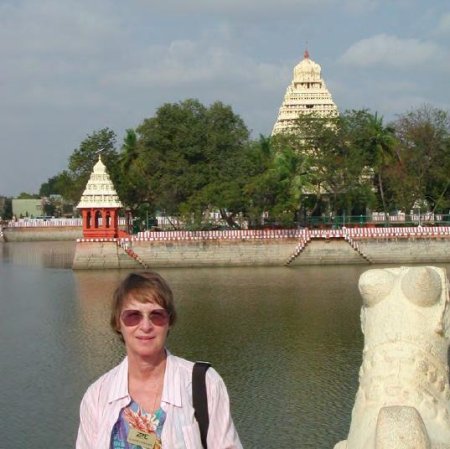
Image: Elisabeth in front of a temple in a small lake in Madurai.
Below is one of the seven large polychrome towers of one of south India’s largest Hindu temple complex, the Shri Meenakshi-Sundareshwarar Temple. Madurai is in the state of Tamil Nadu, where this site is much venerated. As in the Sri Lankan Buddhist temples, visitors to Hindu temples must leave shoes at the entrance.
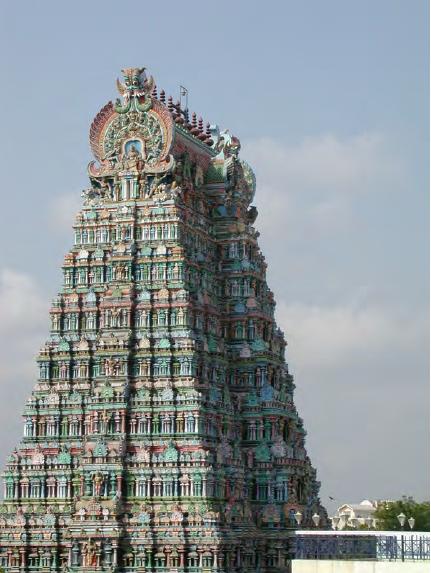
Image: A polychrome tower in Shri Meenakshi-Sundareshwarar Temple.
India and Sri Lanka are third-world countries. Throughout the trip, we were struck by the traffic noise, the disorder, the roadside trash, the tiny retail shops (as we had seen in China), and generally primitive-appearing lifestyle. Water trucks deliver drinking water to people even in Mahatma Gandhi’s Brahmin (high caste) former neighborhood in Bombay. Everywhere people were doing by hand what we in the advanced nations do with machines.
People still head-carry burdens (in Bologna, Italy, a Medieval city, everyone uses wheeled shopping carts). Local deliveries are routinely by bicycle, hand carts, or animal-drawn carts (horse, camel, buffalo). We saw stacks of dried cow-patties (fuel for cooking) on roadsides in Delhi within blocks of the seat of government of this global power.
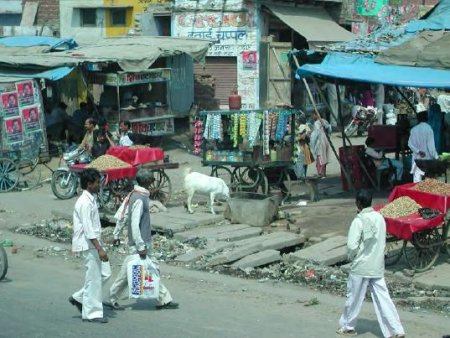
Image: Typical roadside scene: a grazing goat, wheeled carts full of nuts, and one with strings of brightly colored chewing tobacco packets amidst the general disorder and litter.
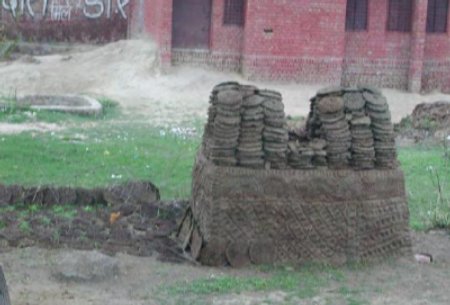
Image: Cow-pattie drying (left), and storage. Note the decorated storage bin. We also saw small thatched-roof shacks used for storage.
Keep in mind, however, that we did not see an accurate cross-section of each community, although tour members asked for the bus tours to drive through ‘good’ sections of towns. In Sri Lanka, the road to Colombo from the airport was a chaotic, commercialized mess, and nothing like the quiet of Arthur Clarke’s residential neighborhood.
Elisabeth spent a lot of time shooting ‘guerilla’ photos from the bus; otherwise, we would have pictures mainly of old forts and temples.
Indian women float like butterflies, in colorful saris or salwar-kameez outfits (long tunic and scarf over long pants), walking with grace and perfect posture through the dirt and chaos and traffic. Elisabeth couldn’t take enough photos of the contrast this makes in the landscape.
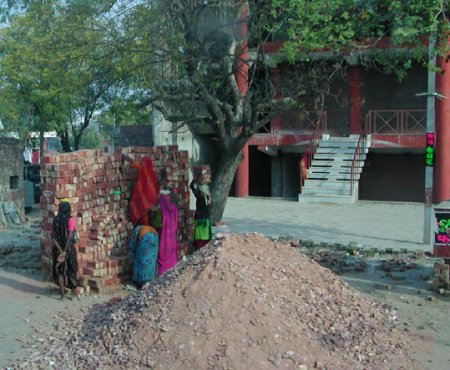
Image: According to one of our guides, the sari is the ‘official’ dress of India. Even women engaged in hard physical labor wear saris; there are no work clothes, not even hats! Women harvested mustard seed with hand sickles, or carried loads of bricks, as above, (on their heads) or patted cow dung into large patties while wearing bright colored saris. Women in the cashew nut factory all wore the company uniform sari. State monument and street sweepers also wear sari uniforms (pink, in Jaipur). Chinese peasants have it easier; they wear big straw hats and sensible pants suits in the fields.
Indian men’s clothes are more westernized. In the south they wear untucked shirts over trousers or sarongs. In Delhi it was virtually all western shirts and trousers (suits for the wealthy men in big hotels).
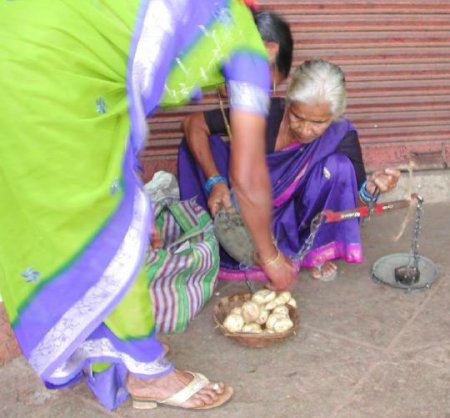
Image: Wearing fancy saris, two women weigh food in an antique balance scale outside the central food marketplace in Goa.
The women on the tour forayed into the clothing shops and emerged with long tunics, scarves, and floppy pants. Californians have a great advantage over Easterners; we can wear the bright colors! We all went home with groaning bags of Indian clothes and crafts, mostly very inexpensive (if you don’t count the trip cost!).
Then south by bus to the coast, where our French ship, Le Levant, ushered us into elegant staterooms and well coordinated programs. Great food, careful handling, generally superb. Elisabeth was pleased to speak French to the crewmembers and not have to eat Indian food all the time. Greg had spent two previous month-long trips to India, roughing it around the north, largely on his own. Time to take it easy!
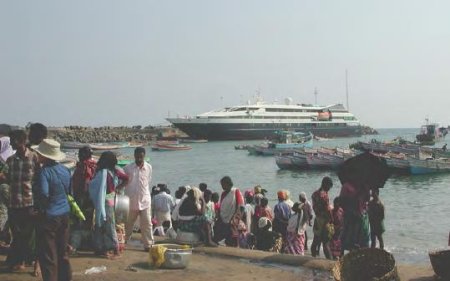
Image: Le Levant docked in Vilijam, in Kerala state. In the foreground is the fish market. Note the working women in saris; some with umbrellas.
Around the southern point of India we went, sailing along the west coast states of Kerala and Karnataka. We stopped each day at a port town, went onshore for experiences — farming, rubber plantation, fruit harvesting, cashew nut processing, plus the inevitable temples, churches, local architecture, and even a synagogue from 1568. Heat, humidity, rich smells. And souvenir hawkers!
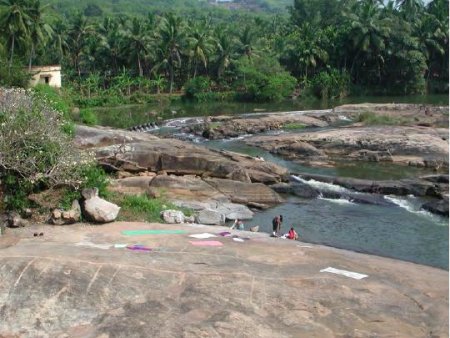
Image: Al fresco laundry in a river a few miles inland. Note that the rock face is scored and numbered to keep clients separate.
Cochin was especially interesting; the state of Kerala has hosted international visitors for millennia, including Jews after the Diaspora, Arabs, Dutch, Portuguese, and finally the British.
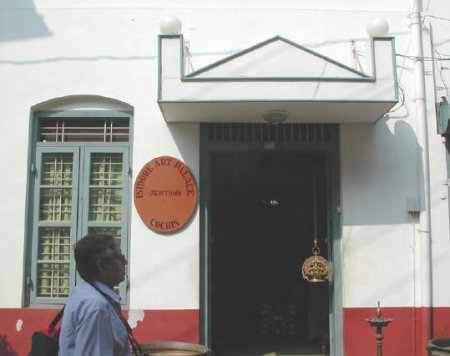
Image: Just up the street from the Synagogue; note the ‘Jew Town’ sign. This is not politically incorrect, merely precise.
We watched antiquated Indian fishing techniques, using big dip nets (‘Chinese’ nets), and circular throw nets just as Greg once did on the Gulf Coast, and his relatives still do. But here they get little fish and crabs, with shrimp the best haul, and few per cast. The entire coast is fished out; a marine naturalist commented on the many undersized fish in the markets.
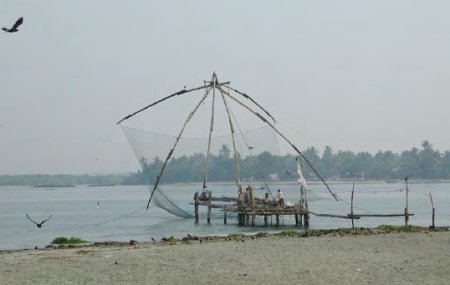
Image: Black kites circle a raised Chinese net. A counterweight of rocks allows the men to lower the net to the bottom of the channel.
One oddity was the mud-fishing by poor women who walked neck-deep through the muddy water, towing empty aluminum water jugs. They massage the bottom sludge with their feet, feeling the mud smelt that hide there. When one stirs under a foot, they can
propel the thrashing, palm-sized smelt up with their feet, grab it in hand, and pop it into their jugs. With plastic bags over their hair to keep off sun and water, they earnestly work their way in teams along the bay. The smelt they catch are smaller than their palms.
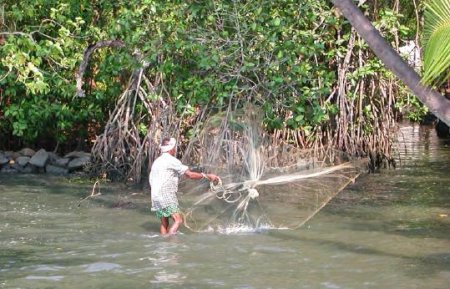
Image: Cast fishing off the coast of Cochin.
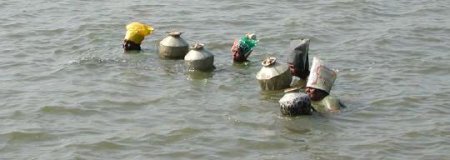
Image: Women mud-fishing with their feet in Cochin.
Greg tried a milk-white ‘toddy’ that smelled of raw rubber, but was fermented coconut palm sap. A toddy-wallah climbs the palm periodically to harvest the sap, using a ladle. Fierce, sharp, warming the belly: nature’s cocktail. This is not the same as coconut water drunk with a straw right from the freshly opened coconut. The latter is available everywhere; in the shell, from carts and small roadside stands.
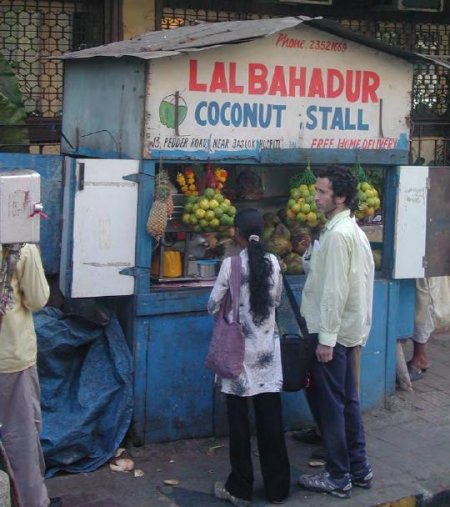
Image: Stalls selling coconuts, fruit, and flowers are common all over the south of India. This one is in Bombay.
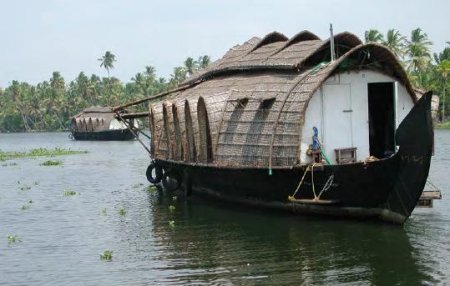
Image: In houseboats, we cruised Cochin’s backwaters, passing extensive rice paddies and small agricultural settlements.
At a beachfront hotel in Goa, a former Portuguese colony and internationally popular resort, Greg bodysurfed the warm waves of the Arabian Sea, which was much like the Gulf Coast of Alabama. Elisabeth tried the swimming pool instead.
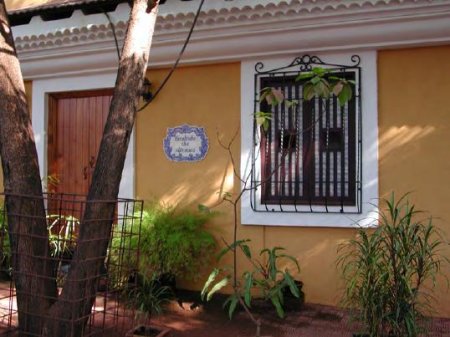
Image: Goan buildings are brightly colored, with white trim. The sign is in Portuguese.
The tour left the ship in Bombay harbor and moved to the imposing and historic Taj Palace Hotel. Southern India is disorganized and dusty, but there aren’t quite so many people, either. The north never lets you forget what it means to travel in a nation of 1.2 billion. Even in an over-air-conditioned room in a giant hotel you hear mad beeping outside from the cars—the horn is a basic tool, used to announce overtaking someone.
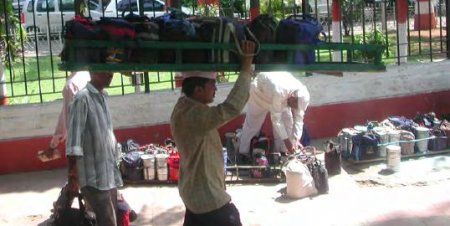
Image: Commuter trains are so crowded that men working in the city have to have their lunches delivered separately by lunch-wallahs; hundreds of thousands are collected, delivered, and returned home every day!
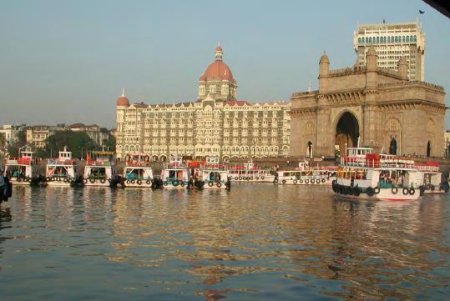
Image: The Taj Palace Hotel, the small boats harbor, and the Gate of India, an 18th century stone archway. The tower behind the Gate is the Bombay stock market. Our room faced the harbor.
The carved caves of Elephanta Island, just across the bay by ferry, were mysterious. The Portuguese blasted some of the carvings with rifles since they were ancient religious images of Shiva, Krishna, etc.; insults to Christ. But they didn’t dare attack temples very much. The Brits wisely left religion alone entirely.
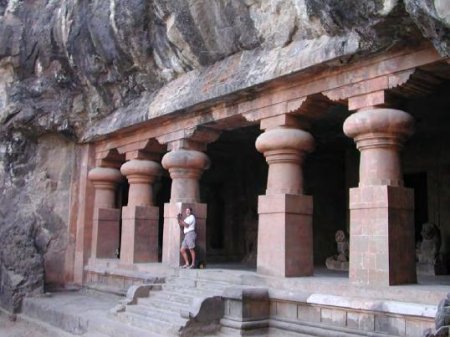
Image: The caves of Elephanta Island were carved out of the local sandstone and may be 1500 years old. The carvings are mostly of Shiva, the Hindu goddess of destruction.
We stayed in Taj chain hotels when not cruising; top of the line. Swimming pools, wireless, fine food, plentiful staff. The pools are tiled in blue, rely on the sun for heating, and keep one fresh, though not all have a heavy machine gun brooding over them. Elsewhere this luxury would isolate you, but in India it’s a good idea. The wear and tear of travel, especially overland, is large.
The “cobra roads” are rocky, traffic a nightmare (and opposite handed), while everything runs on IST— Indian Standard Time, which becomes Indian Stretchable Time. Very modest road improvement from Greg’s two earlier trips- 22 and 10 years ago.
The moist heat penetrates to the bone. Crowds are huge, poverty lurks everywhere. Education is better in the south, though political power is in the north. When Indians laud their diversity, they really mean their many religions and castes; there were few black or oriental faces.
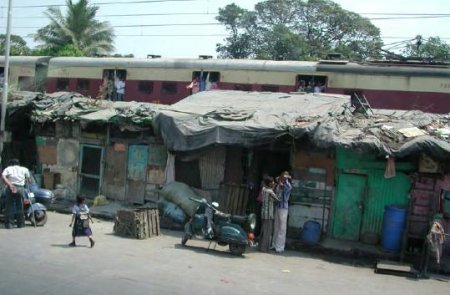
Image: Slums are permanent fixtures; in Bombay they had street numbers. These line the railroad tracks; in other towns they line river banks. Note the crowded commuter train in the background.
We flew to Jaipur, the pink city, and saw the 16th C. astronomical observatory, used to get accurate planetary orbit information, about the same time that Kepler was figuring out elliptical orbits in Poland. Women there wear very colorful deep red saris that work well with their dark, smooth skin.
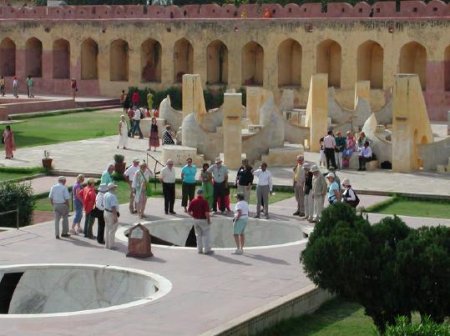
Image: Imagine larger-than life copies of scientific instruments, and you have the Jantar Mantar Observatory, built by the astronomer Sawai Jai Singh in 1730. The marble is precisely inscribed with measurements.
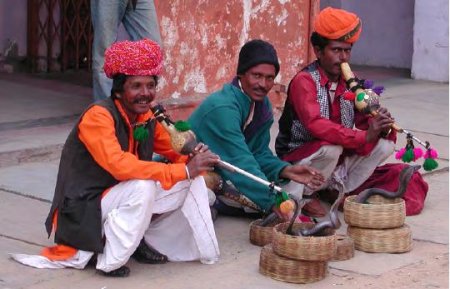
Image: Jaipur was very exotic; also lots of beggars and monkeys. Jaipur-Agra-Delhi is India’s main tourist triangle, so they’re waiting for us.
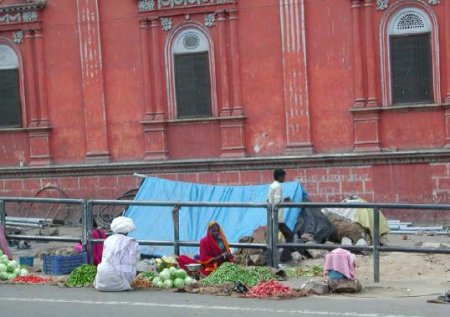
Image: Life is lived on the streets of the old pink walled city of Jaipur. Here vegetable vendors work just outside the family’s tent.
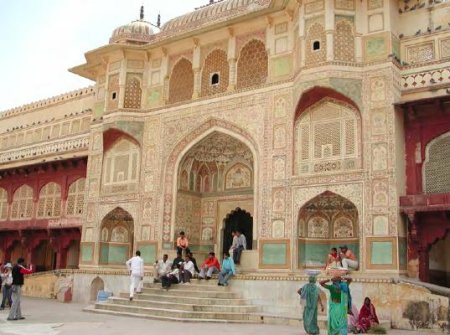
Image: Amber Fort is a spectacular abandoned city built on a ridge outside of Jaipur by a Mughal emperor. Note the women in green saris (r); they carry trays of rubbish and building supplies on their heads.
Onward then, in grinding bus trips to Agra and the Taj — indescribably beautiful, so we won’t. It still seems odd to Greg, despite two earlier, month-long trips to India, that the most beautiful building in the world is a tomb. Ethereal in its grace, hanging in the sky like a vision. Yet it’s about death, and the perpetual wish for eternal life. There’s even a cremation ghat nearby on the river.
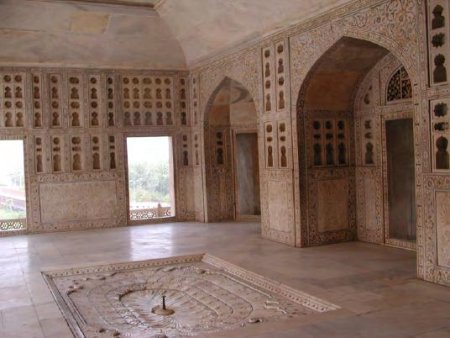
Image: The carved and inlaid marble apartment in Agra Fort where the Taj builder and deposed Mughal emperor Shah Jehan was imprisoned by his son. He could see his wife Mumtaz’s tomb from the windows.
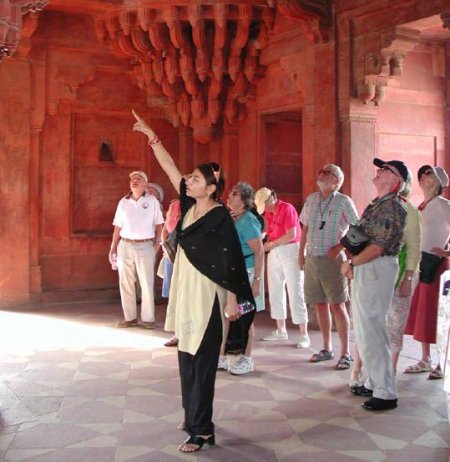
Image: A local guide, Shika, in her salwar-kameez, at the Hall of Audiences at Fatephpur Sikri, an abandoned Mughal sandstone city near Agra.
Everywhere springs a colorful profusion of temples, religious icons and symbolism. The opiate of India is indeed religion. It and China alone have religions with reincarnation, the cycle of time supposedly going back infinitely far. Buddhism came from India and caught on better in China. These two vast, ancient societies withstood the centuries by keeping down innovation, so life was much the same from one millennium to the next. Centuries slid by with little to mark them beyond the feuding of maharajahs. Maybe that’s key to why the wheel of life idea works so well there. Notably, one of the few diehards supporting the Steady State theory in cosmology is Wickramsingh, a Brahmin; maybe he feels a cultural resonance.
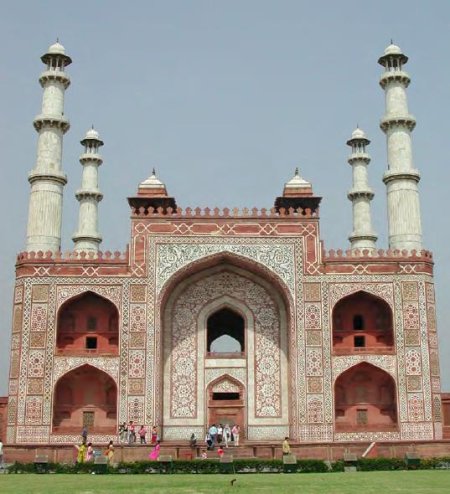
Image: Looking much like one of the outer gates of the Taj, Sikandra is the mausoleum for another Mughal emperor, Sha Jahan’s grandfather, Akbar.
The air was thick with mortality. Tombs of emperors loom over traffic roundabouts, abandoned forts of red sandstone stand ready to defend shopping malls, street names reflect dynasties that lasted centuries. You see in passing turbaned Sikhs and sleek Bengalis, dark and beautiful Tamil women from the moist south, Rajputs ablaze with jewelry, raw Kashmiris smelling of untanned leather, uniformed soldiers clumping by, black-cloaked Muslim women, peasants hauling bullock-drawn freight from the scorched Punjab plains.
Beggar children know to murmur key words—”mummy,” “hungry,” “please,” “baby”—in soft despairing tones to snare the hurrying stranger. They and the hawkers throng the tour buses and sites, earning their keep with lifted palms, to live in the shantytowns of packing cases and rusty tin that line bustling avenues. Gandhi said the voice of the people was the voice of God, but it was hard to see a divine element in the grinding poverty.
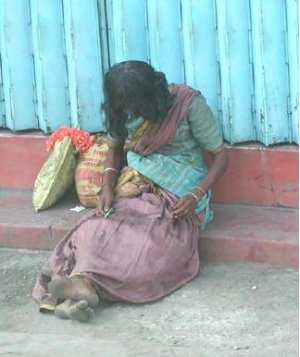
At an ordinary town’s edge is the usual rubble: vacant-eyed children, vivid plastic bits, sagging shacks that shade listless adults, dogs bent or crippled, scrawny chickens pecking through litter, ugly sweet smells from stagnant ditches, brown fruit peelings awaiting a passing pig, cow patties drying on a wall. Some women seemed at ease as they squatted to soap themselves and then their clothes in rain puddles. Misery hangs in the air. One sees stories drifting by in a single glimpse: a sick dog eating withered grass, a twisted leg, an ancient brown woman squatting so that she could lift her matted sari away from the road, to relieve herself while she watched traffic with glittering eyes.
Image: Beggar woman in Madurai rests after combing her hair.
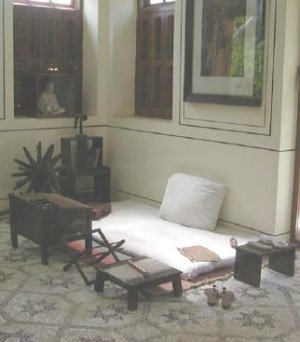
Yet there was beauty, too. Pied wagtail birds flitting, their eager grace somehow heartening.
India’s socialist beginnings served them poorly as population swelled. Delhi started in their 1947 independence with 250,000; now it has 14 million, thanks to the huge bureaucracy, and a flood of immigrants fleeing Pakistan after partition. Their constitution wrote in ‘preferences’ (job quotas) for the lower castes, rules which were slated to go away in a generation, but now seem permanent. Political pressure expands them steadily, recently adding “tribes” (ethnicities)—and many political parties based on these favors want to do more. A useful lesson on affirmative action taken to extremes.
Image: Mahatma Gandhi’s room in Bombay.
The many newspapers in English have a curiously vague tone. They say “communal disturbances” for the incessant Muslim-Hindu strife. Most news is written in passive voice—as Orwell observed a half century ago, to evade responsibility. Criticism of the US is common. One whole page advocated taking the Internet’s basic controls away from the US, which makes access free to all, and handing it to the UN or some other body. The subtext seems to be to first internationalize, then tax it.
Delhi is a powerhouse.
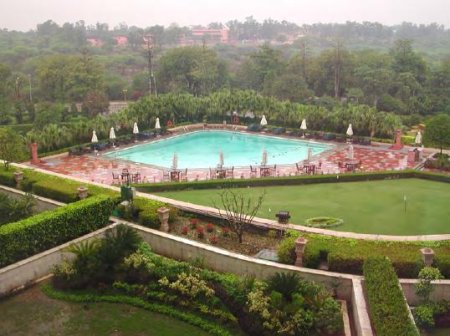
Image: View from our hotel room, at the Delhi Taj Palace, facing the large forest embedded by the Brits in the new southern half of town (‘New’ Delhi), with its broad avenues, open green lawns, and large buildings of state.
The Victorian houses have arched doorways twelve feet high, as if awaiting a family of acrobats who would need to walk between rooms while still stacked on each other’s shoulders. Indeed, India’s survival is acrobatic at times. They have come through the hard decades of socialist poverty and, since the early 1990s, are finally emerging, using market forces to get jobs and decent conditions throughout the land. There is still an ocean of poverty, and nothing will work if family size doesn’t drop; over half of the country is under 25 years old.

India views technological problems quite differently. They import 60% of their energy needs and 90% of their oil. The Energy Minister announced while we were there that India will quadruple its coal burning by 2030, shrugging off the entire idea of carbon restriction as a method to restrain climate change—even though, in the tropics, they have the most at risk. Greg tries to explain this to climate scientists at home who hold with the prohibition-only stance, but they cannot grasp how differently the developing nations see the problem. Basically, those countries think it’s up to the prosperous nations to fix it. Similarly, the Indian space program sees itself as a rival to China, not to the US or Europe. It will be amusing if audacious moves in space come from Asia as a regional competition, just as the US-USSR contest drove the first decades.
Image: Old Delhi: Chandi Chowk bazaar.
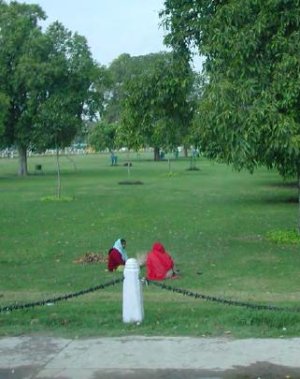
In Delhi one easily gets the point of Kenneth Galbraith’s remark, that India is ‘a functioning anarchy’. Mahasweta Devi’s more literary take is that India walks “hand in hand with the new millennium, whistling a tune from the dawn of time.” So the nation of Gandhi has nuclear weapons.
The trip had run 25 days and we were ready to go home, after a stop in Singapore for business. The dusty Delhi airport is like a Mexican one of 30 years ago. Crowds massed at the entrances to canyons of barren, bare concrete, without even any shops. In comparison, our few days in Singapore were dramatic: it’s clean, prosperous, orderly. Another Brit colony, rich in history.
Image: New Delhi: acres of lawns and broad boulevards.
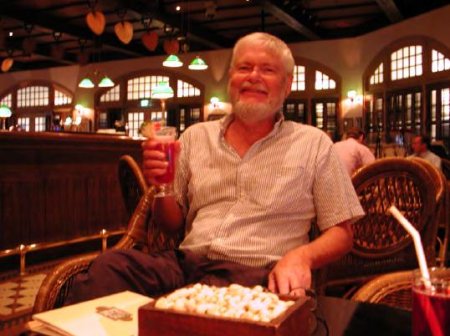
Image: For $22 US Greg had a Singapore Sling in the Long Bar of the famous Raffles Hotel — mahogany, teak, fans flapping from the ceiling — which boasts a museum about its own history.

Image: The Singapore botanical gardens were our high point — lush tropical zones, a wonderful orchid garden, exotic birds.
Greg looked into moving to Singapore an intellectual property biotech company he co-owns, because it’s far easier to defend property there than in lawyer-plagued USA. The Singapore government even gives grants to get high tech into the country. He had explored this in India, only to learn that, realistically, it would take a year of bureaucratic delay, to be dodged only by generous baksheesh. Sobering.
Singapore is known for its tough-minded policies; the sign in the airport says that the penalty for illegal drug smuggling is death. Though they’ve repealed the strict laws against littering, spitting etc., it’s nothing like free-wheeling Hong Kong, where sari-clad Indian prostitutes accosted Greg outside our hotel, offering services that fell in price within seconds as he brushed them off. In a supposedly communist country! But Singapore is culturally diverse, with an educated population. Try having a cogent conversation about local economics with a taxi driver anyplace else!
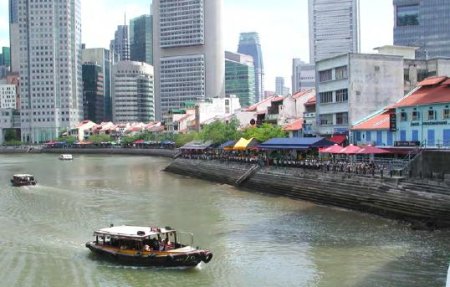
Image: Riverwalk, a district of jazz clubs and restaurants at the site of the old central food market. is a little bit of cleaned-up past at the feet of the skyscrapers of the new Singapore.
After 28 days, we headed home. This glance into four very different former British colonies had revealed much, seen from the American angle. Everywhere the press of crowds reminds that the US is a rather under-populated land – and the price of letting that change. Passing through a village, thousands of faces stare back—people just sitting, with nothing much to do.
Of them, Singapore and Hong Kong are far more polished and prosperous, perhaps because they blend Chinese and other cultures well. Sri Lanka is a beautiful land, but India promises the most for the future. Dusty, disorderly, corrupt, yes—but vast and powerful, when it can decide what to do. These nations are the newest addition to what Greg calls the Anglo Saxon Empire—one of culture, not class or race—and could become the true leader of all Asia. Greg hopes they do; Elisabeth thinks they are hag-ridden with superstition, astrology, religion, and a staggering population, and are not ready for a great leap forward.


I find it interesting that in so many cultures, our “western” one included (with our ornate churches, monuments, corporate headquarters, and mansions) , that we tend to have such elaborate and expensive buildings devoted to religion or to our human leaders, right along side all the seemingly unremarkable people who focus on surviving day to day. The inequities seem timeless, perhaps an implicit trait of human nature.
I could go on (I did try), but I best get back to work.
I am grateful for this opportunity to see us as we are on the other side of the planet where I doubt I’ll ever be able to visit.
Marc
Truly a fascinating article, especially the comments about India. The pictures are wonderful. I’ve sat at that same bar in Raffles, though this was in the late ’80’s – I don’t think that Slings were that expensive back then.
The building behing the Gateway of India (one of the pics above) is not Mumbai’s stock exchange. Its the New Taj Hotel Building. The one on the left id Taj Heritage. Just thought of correcting you. I liked all the pics and details very much.